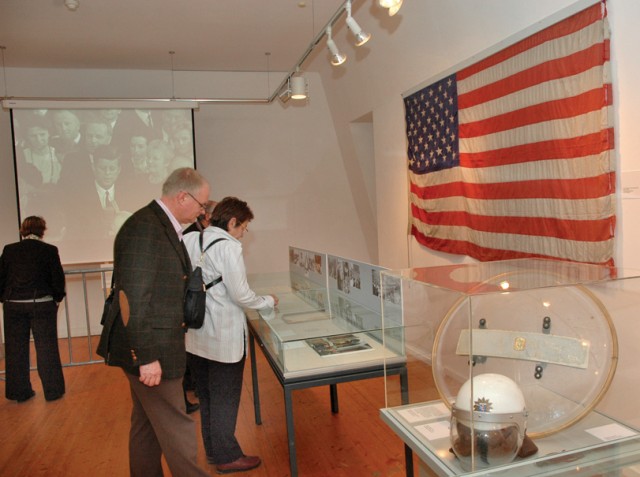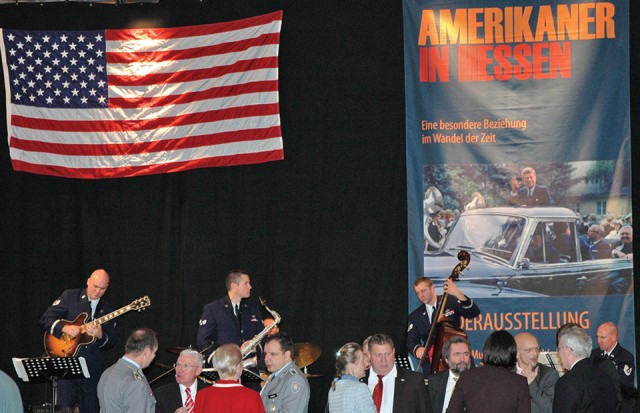HANAU, Germany - Even though officials last month returned Pioneer Kaserne - the last remaining U.S. military installation in Hanau - to German government authorities, the Americana spirit still thrives here.
The city of Hanau has opened an "Americans in Hessen" exhibition, as hundreds of guests enjoyed the Nov. 20 opening in Hanau's Schloss Philippsruhe (Castle Philippsruhe).
"This is one of the most spectacular exhibitions mounted in our young history here in Hanau," said Lord Mayor Claus Kaminsky, welcoming German and American visitors.
Praising the close cooperation between Hanau and the U.S. military community, Kaminsky said: "This is a very moving event for the citizens of Hanau. We owe you a debt of thanks. ... After World War II, the Americans extended the hand of friendship, which brought us from the past into the present."
Referring to the Marshall Plan and "redemocratization" of Germany, Kaminsky noted how Americans and Germans became ever closer in the six decades following the war.
"Through cooperative efforts, much was achieved in Hanau. Without American contributions, Hanau wouldn't be what it is today."
While the U.S. military entered Germany as victors and occupiers, they didn't hesitate in helping to clear away the rubble of World War II's massive destruction and in reconstruction, the lord mayor said.
Among the memorable highlights of the American presence in the city, Kaminsky recalled, were visits by President John F. Kennedy in the early 1960s and the emotional support rendered by the citizens of Hanau following the terrorist attacks on New York and Washington, D.C., in 2001.
"Many people in Hanau can still remember where they were that day (when Kennedy visited Hanau's Fliegerhorst Kaserne) and many were on the streets lining his procession. ... The experience of authentic solidarity and thanks (when Germans turned out in en masse to bring flowers and emotional support to U.S. caserns in Hanau after Sept. 11, 2001) was a very special, moving moment."
The Americans in Hessen exhibition reflects those close ties, Kaminsky said, adding that it is a one-of-a-kind display.
"You came as liberators - some as victors - but you quickly became our friends," noted Hessen Social Ministry State Secretary Gerd KrAfA$mer. "Our history is closely tied to the Americans who served here. ... Hessen, like Hanau, profited immensely from our relationship with the Americans."
Describing how more than 12 million Americans stationed in Hessen over the years learned to appreciate Germany - and how Germans grew up with the same perspective about America thanks in part to friendships with Soldiers and the American Forces Network - KrAfA$mer said now that will change with the Army's transformation push. As fewer Americans serve in Germany, he explained, both sides will have to make greater efforts to maintain a better understanding of one another.
The Hessen ministry official also noted that things were not always rosy between the two nations. "We were friends who didn't always understand one another politically, but we remained friends."
The evening's chief speaker, Karsten Voigt, the German government's German-American cooperation coordinator, detailed the sometimes stormy political differences between two allies - particularly during the Vietnam War and Global War on Terrorism. And despite differences, democracy thrived and West Germans were free to express their differences - a stark contrast to repression forced on Germans living on the other side of the Iron Curtain. "If we in western Europe didn't do what the Americans wanted," Voigt said, "they threatened (to withdraw) from Europe. That wasn't exactly the case with the Soviets in the East."
As for the ongoing exhibit, its visitors are greeted in the ornate palace by signs donated by the Hanau military community: a large 1st Armored Division crest; Hutier Kaserne installation marking; and other symbols familiar to those who lived and worked in Hanau over the years. As one proceeds through the exhibit, multi-media installations depict the lifestyle and relationships of those who inhabited Hessen for more than half a century - from the Elvis years to the closing of caserns in BAfA1/4dingen, Darmstadt, Frankfurt, Giessen, Hanau and other towns.
The Americans in Hessen exhibition runs through March 29, 2009, in Hanau's Historical Museum in Schloss Philippsruhe, located on Philippsruher Allee 45. It is open from 11 a.m. to 6 p.m., Tuesday to Sunday. There is an admission fee.




Social Sharing